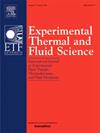Ripening of capillary-trapped ganglia in porous media
IF 2.8
2区 工程技术
Q2 ENGINEERING, MECHANICAL
Experimental Thermal and Fluid Science
Pub Date : 2024-11-30
DOI:10.1016/j.expthermflusci.2024.111364
引用次数: 0
Abstract
The Ostwald ripening behavior of ganglia within porous media has significant applications in various fields, including CO2 geological sequestration, porous material fabrication, and fuel cells. Although the ripening behavior of bubbles in porous media has been extensively studied, current research primarily focuses on bubbles occupying individual pores within the media. In contrast, in practical scenarios, it is more common for ganglia to span multiple pores within the porous media. Microfluidic technology was employed to create heterogeneous porous media chips with regions containing both large and small pores, as well as a chip designed to simulate the structure of actual porous rocks. Long-term visualization tests were conducted on the Ostwald ripening process of the CO2 ganglia, and changes in ganglia volume and capillary pressure were quantified. It was found that the geometric dimensions and distribution of pores and throats in heterogeneous porous media significantly influence the ripening behavior of ganglia. The ripening process of ganglia occupying multiple pores was more complex than that of bubbles occupying a single pore. It was also discovered that the ripening process of ganglia is slower than bubbles occupying single pores or in bulk fluids. This phenomenon is attributed to the interfacial stabilization in ganglia during ripening, which inhibits the increase in capillary pressure differences, and the pore structure that restricts the effective area for mass transfer. These findings are crucial for optimizing CO2 geological sequestration strategies and designing porous media materials.
求助全文
约1分钟内获得全文
求助全文
来源期刊

Experimental Thermal and Fluid Science
工程技术-工程:机械
CiteScore
6.70
自引率
3.10%
发文量
159
审稿时长
34 days
期刊介绍:
Experimental Thermal and Fluid Science provides a forum for research emphasizing experimental work that enhances fundamental understanding of heat transfer, thermodynamics, and fluid mechanics. In addition to the principal areas of research, the journal covers research results in related fields, including combined heat and mass transfer, flows with phase transition, micro- and nano-scale systems, multiphase flow, combustion, radiative transfer, porous media, cryogenics, turbulence, and novel experimental techniques.
 求助内容:
求助内容: 应助结果提醒方式:
应助结果提醒方式:


